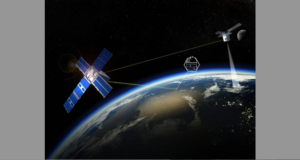General Atomics Electromagnetic Systems announced June 2 that it has completed ground tests of the 12U cubesats equipped with laser communications terminals.
The Space Development Agency will use these satellites to test optical crosslinks as well as communication between satellites and a pilotless MQ-9 Reaper drone made by General Atomics Aeronautical Systems.
Seamless connections between satellites and other military platforms via optical links is a key hurdle the Space Development Agency hopes to clear as it prepares two deploy a large mesh network of small satellites in low-Earth orbit. The constellation known as the Transport Layer is being designed to pass huge amounts of data from satellite to satellite, from satellites to the ground and to aircraft in flight.
The space-to-air experiment is “one of the first steps to validate the use of optical communications to provide low latency, secure data directly to weapons and warfighters,” said Scott Forney, president of GA-EMS.
The cubesats each hosts a C-band dual-wavelength optical communication terminal and an infrared payload. They will attempt to communicate with an optical terminal on the MQ-9 aircraft flying at approximately 25,000 feet.
“Optical communication to an air, ground, or maritime asset proposes a different set of challenges than space-to-space communication, because you have to account for distortions to the optical beam caused by atmospheric elements like weather, clouds, dust, and even wind,” said Nick Bucci, General Atomics’ vice president of missile defense and space systems. He said the company is using adaptive optics to compensate for such distortions.
During the demonstration, the Space Development Agency and GA-EMS will measure data rate, bit error rate and acquisition times — or the ability for each spacecraft to point, acquire and track the other to establish and maintain the link.
Bucci told SpaceNews that the space-to-air flight demonstration will last for two weeks. During that time, the drone will fly at different altitudes and orientations, he said. The goal is to see if during maneuvers the optical terminal on the crone can still take a cue and perform data acquisition and transfer.
Also on the Transporter-2 mission will be a second DoD laser communications experiment known as Mandrake 2. Two cubesats made by Astro Digital will carry optical terminals from SA Photonics. Mandrake 2 is a joint project of the Space Development Agency, the Defense Advanced Research Projects Agency and the Air Force Research Laboratory.
The satellites were scheduled to launch in January on SpaceX’s Transporter-1 rideshare but they were accidentally damaged during payload processing and didn’t make the launch.
Challenges for SDA
The Transport Layer will have optical communication links but also other types of connections from space to the ground such as Link 16 and Integrated Broadcast Service links.
The upcoming experiments will help the Space Development Agency answer technical questions about the performance of optical terminals but there are other concerns such as whether the industry can manufacture terminals that are compatible with other companies’ terminals.
The agency aims to launch 20 Transport Layer satellites in 2022 and up to 150 satellites in 2024. Each will have three to five optical communications terminals.
Mike Butterfield, optical communications lead at the Space Development Agency, said the manufacturing of optical terminals is a concern. “We have to demonstrate that it is feasible to create a market of multiple vendors that have interoperable optical comm terminals that can fulfill the needs of a proliferated LEO architecture,” he said June 1 at the MilSat Symposium.
The plan is to use terminals with 2.5 gigabit per second bandwidth, he said, “which might leave people scratching their heads” because the industry is producing 100 gigabit-per-second terminals.
The Space Development Agency has to weigh the bandwidth against other requirements such as how the beams perform in the atmosphere when satellites communicate with ground, maritime and aerial platforms, said Butterfield. “We’re choosing to focus our efforts on a single protocol, and to set up the manufacturing side for success by not over complicating the system.”
Debra Emmons, optical communications expert at the Aerospace Corp., said laser links offer significant benefits such as high data rates and greater cybersecurity than radio-frequency communications.
“We’re talking about moving from megabits per second to gigabits for the links, whether that’s cross links, up links or down links,” she said at the MilSat Symposium.
She said optical communications by nature provides “strong anti jam performance and intrinsically low probability of detect and intersect.”
Michael Dickey, director of the U.S. Space Force’s warfighting analysis center, cautioned that while laser links have huge advantages, there is a risk of making the network overly complex. “How you manage that back end complexity is, I think, one of the top challenges,” he said at the MilSat Symposium. “Optical comms obviously will help and I’m a firm believer that it is going to help us, but we have to be careful.”



